Our farm is horse powered. We don’t own or desire a tractor. We plow the fields, cultivate crops, make hay and more with the help of a mother-daughter team of Belgian draft mares, Dixie and Dolly, who were both born right here on the farm and trained by my husband. While an unusual choice for those living outside the Amish and Mennonite communities, we feel there are real advantages to embracing this not-so-modern technology.
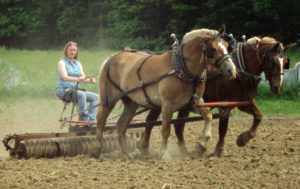
The cultipacker is my favorite piece of equipment to drive.
Draft animal power enables us to be more self sufficient and sustainable. The horses help us make hay, which powers them through the winter. Their manure is spread back over the fields (via a manure spreader they pull) to enrich the soil and help crops, including the hay, to grow. It’s a beautiful, natural cycle where all the outputs are inputs for the next step. We don’t have to buy fuel, or worry about the effect the exhaust fumes may have on the environment. It’s also possible to breed and train more horses, so that you increase or replace your working animals, something that is not possible with machines. Young horses or started teams can even be a source of income for your farm if you have the time and skill to do so.
We have a mix of old & new equipment which allows us to do the necessary tasks from plowing and planting to making hay. Our area is rich in old farms as well as Amish communities. For us, antique equipment can be found at many farm auctions. Our oldest piece of equipment is probably a potato digger which dates from the 1880’s, but we’ve picked up many things this way and been able to see and daydream about even more. Sometimes, we are fortunate enough to cross paths with someone who has an old piece sitting in a barn, taking up space. When we make hay, our hay loader was made by John Deere in the 1920’s, which came to us this way. It was exciting not only to have a hay loader (rather than forking hay by hand on to the wagon), but also to restore such a cool piece into working condition! There are also companies- Pioneer Equipment in Ohio & I&J Manufacturing in Pennsylvania- that make new horse-drawn implements. Our most modern piece is a machine to put down plastic drip tape irrigation, lay down plastic mulch and cover the sides of the mulch all in one pass. While we are grateful to have new equipment that makes tasks easier, we truly love collecting and restoring antique pieces to a functional state, and maintaining the knowledge of how to use them as well. I have several pages on my website that detail our machinery, as it is one of the most frequently asked about topics when it comes to our farming practices!
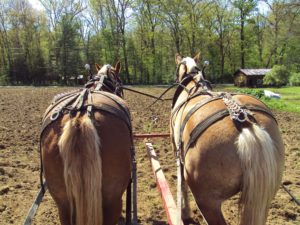
The view from the driver’s seat.
One of the best things about farming on a small scale is the deep ties you feel towards the land. Farming with horses only deepens this connection. There is no roar of a motor to drown out the birdsong as you are tilling the spring fields. No whiff of diesel exhaust to overpower the summer scent of drying hay. The pace is slowed to what you and your team can handle. Small, frequent breaks are necessary for both man and beast. Horses, even those that weigh about a ton each, also do not have the compacting effect on the soil that larger tractors do. We are also able to get out in slightly wetter conditions in the spring as horses don’t leave ruts or get stuck the way tractors will.
Learning how to farm with horses is a rather specialized skill and not always easy to find ways to get hands-on knowledge. Dan’s father chose to farm this way, so he grew up learning everything about powering a farm with draft animals. I was not a farmer when I met Dan, but I had 15 or so years of experience riding, handling and training horses which gave me a solid base to build on. I was also grateful for a stack of old issues of the Small Farmer’s Journal, because it is very focused on draft animal power. The articles gave me a much better understanding of many aspects of farming and were a great way to spend winter down time learning.
I truly love the idea of preserving part of America’s farming heritage in a number of ways. I grow heirloom vegetables, and raise heritage breed livestock. We are lucky to be stewards of a farm that has been worked continuously since it was a land grant for military service just after the Revolutionary War. But it’s the practice of farming with horses and maintaining the knowledge of how to use antique equipment that is possibly the most special or rare. We do it simply because we love it, not because we are Amish and it is dictated that we must by our religion or community.
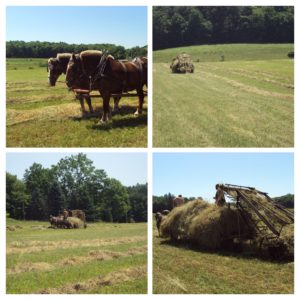
Making hay with our team and 1920’s era John Deere hay loader.
This is not to say that horse farming is for everyone though. Unlike a tractor, you can’t park the horses in the barn for the winter and forget about them. They need care every day of their lives, which can stretch over 30 years. But the horses are not merely a tool, they are living, breathing partners in what we do. They come at the sound of Dan’s whistle, running to the barn from the far reaches of the pasture. They stand patiently to be harnessed, and can be commanded pretty much by voice alone. It is amazing to hold two pieces of leather and know that is all that imposes my will onto a pair of animals that weigh approximately a ton each. And yet, we move through the fields, completing tasks that help the farm to function. They trust our guidance and lend us their power. It is a privilege to work with them.





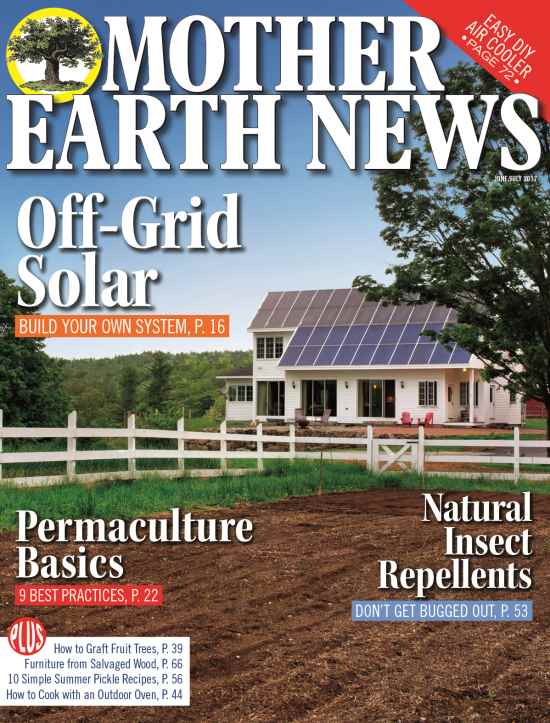




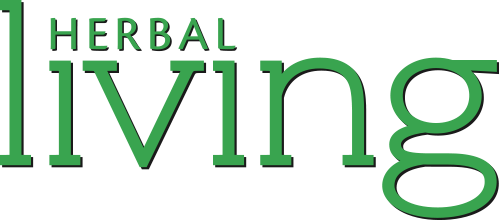
1 Comment
[…] https://homestead.motherearthnews.com/amish-farm-draft-animal-power/ Are You Amish? Why We Farm With Draft Animal […]